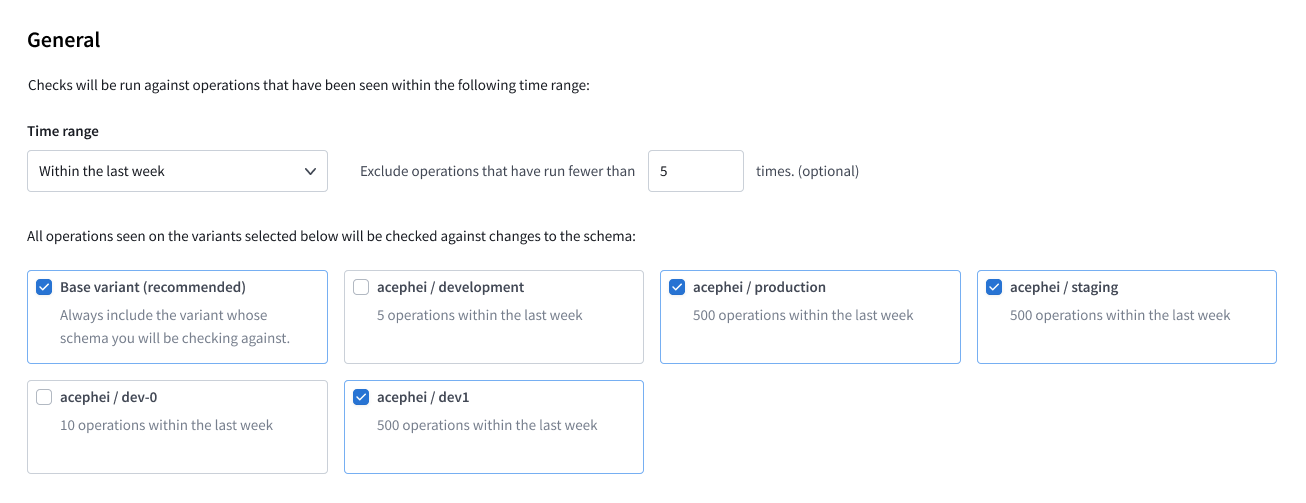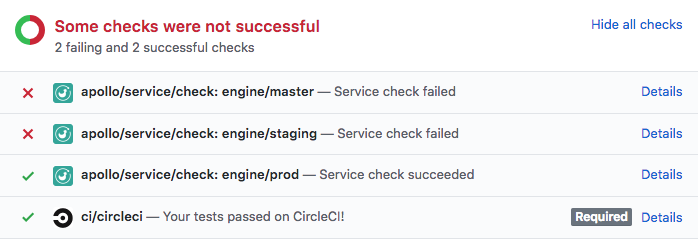Configuring schema checks
Define exactly what schema changes are checked against
After you enable schema checks for your graph, you can customize their behavior to suit your use case. For example, you can:
- Exclude past operations that were executed by a particular client, such as a client that you only use for testing
- Exclude past operations that were executed relatively infrequently
- Check schema changes against multiple graph variants
Using Apollo Studio (recommended)
In Apollo Studio, you can configure default rules that are applied to every executed schema check. You define these rules from the Configuration tab of your variant's Checks page:

Configuration options
Time range: Include all distinct operations that were executed within this range. The default value is 7 days ("Within the last week").
Operation count threshold: Exclude all operations that were executed fewer than this number of times within the specified time range.
Variants: Include all distinct operations that were executed against each selected variant of your graph. The default value is "Base variant" (i.e., whichever variant schema checks are being run against).
Client exclusions: Exclude all operations that were executed by particular clients, such as clients used exclusively for development and testing.

Using the CLI
You can customize a single run of schema checks by providing options to the Rover CLI. If you've also configured default rules for schema checks, any command-line options you provide take precedence over those rules.
Validation period
You can provide the --validation-period option to specify how far back in time Studio should look when determining the compatibility of past operations with the changes to your schema (by default, the command uses the last 7 days of operations).
This command checks schema changes against the past two weeks of operations:
rover subgraph check docs-example-graph@current --name products --schema ./schema.graphql --validation-period="2 weeks"
Valid durations are represented as any combination of years, months, weeks, days, min, and sec:
1 month 2 weeks525600 min
If you specify a --validation-period that exceeds your organization's operation retention period, the subgraph check command fails with an error.
Threshold values
You can provide threshold values to Rover to ignore historical operations that are relatively rare.
For example, you might want to discontinue support for an old version of your client that uses deprecated fields. You can set threshold values to determine when an acceptably small number of users are using the outdated client, thus reducing the impact of discontinuing support.
Provide threshold values with the following flags:
--query-count-threshold- Check your schema only against operations that have been executed at least the specified number of times within the specified duration.--query-percentage-threshold- Check your schema only against operations that account for at least the specified percentage of all operations against the graph within the specified duration. For example, specify3to set this threshold to 3%.
Note: You can provide values for both of these flags. If you do, an operation must meet or exceed both thresholds for schema checks to include it.
Here's an example of running rover subgraph check with threshold values:
rover subgraph check docs-example-graph@current \# Path to schema file--schema ./schema.graphql# Name of subgraph with schema updates--name products# Check the schema against operations that have run in the last 5 days--validation-period="5 days" \# Only check against operations that have run at least 5 times during the 5-day duration--query-count-threshold=5 \# Only check against operations that account for at least 3% of total operation volume--query-percentage-threshold=3
To request other filtering or threshold mechanisms, please get in touch with us on the Rover repository.
Checking against multiple environments
You might want to check schema changes against multiple environments, such as production, staging, and beta. Each of these environments might have a slightly different schema to support features that are experimental or in active development. In GraphOS, these schemas are represented as variants of a single graph.
You specify which variant you want to check against in the graph ref you provide to rover subgraph check:
rover subgraph check docs-example-graph@staging --name products --schema ./schema.graphql
The graph ref docs-example-graph@staging specifies the staging variant of the docs-example-graph graph.
To check your schema against multiple variants, call rover subgraph check once for each variant. Doing so results in status checks similar to the following:
